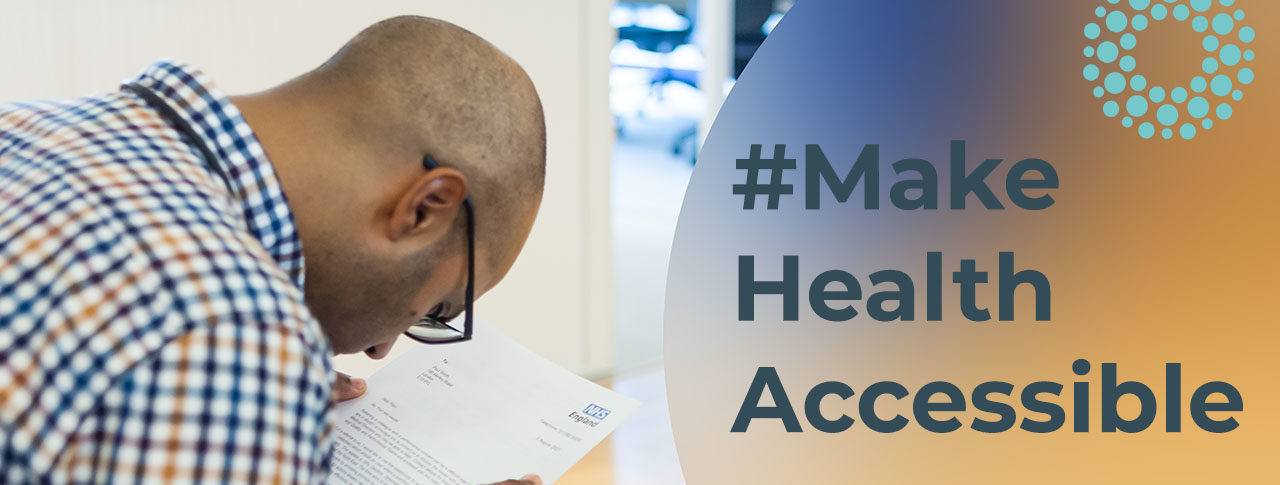Top tips for applying the Accessible Information Standard #MakeHealthAccessible
Our #MakeHealthAccessible campaign calls on the NHS to effectively implement the Accessible Information Standard and engage with #VisuallyImpaired patients.
Download our accessible, downloadable resource
We have created a fully accessible, downloadable and printable guide, written by blind and visually impaired members, that is aimed at health and social care professionals and management teams. Alternatively, you can read our top tips below.
Download our Top Tips for Implementing AIS resource
Context
- NHS England introduced the AIS in 2016 so that anyone with special reading requirements, such as blind and partially sighted people, can receive critical health information in their preferred format.
- The AIS was also intended to help agencies meet clear legal requirements in this area under the Equality Act 2010.
- Despite the AIS and its basis in law, most blind and partially sighted people still report regularly failing to receive health information in a format they can read.
- The common cause reported is that professionals have never heard of AIS, let alone the tools to apply it.
About This Guide
- It is aimed at health and social care professionals and management teams and was written by blind and partially sighted people.
- It offers simple tips, encourages professionals to get in touch with Sight Loss Councils and other disability charities for advice and guidance and urges them to consult individuals on their personal needs without making assumptions.
Basics
- The AIS is relevant to everyone! From reception staff to heads of department, informing your actions with AIS knowledge could be life-changing for blind and partially sighted people.
- Readable formats can include Braille, large print or audio, but also electronic versions instead of hard copies.
- The AIS applies equally to a leaflet handed out by a GP, sight of a person’s medical notes or an appointment letter.
- You can get advice on transcription, into braille or audio for example, from RNIB or Thomas Pocklington Trust.
- These charities can also provide information on accessible digital information, such as on apps or websites.
Steps You Can Take
- AIS Policy – create a stand-alone policy or add to any existing access policy and create an immediate positive impact on patient well-being.
- Training – use such a policy to influence accessibility training for all staff.
- Embrace digital – the AIS gives guidance on offering accessible files, apps/websites and contact by phone or text; all impactful means to help a patient group use technology more and more.
- Consult – gaining views f rom real people with disabilities makes it far easier to gauge success against the AIS and make improvements.
- Regular reporting – asking this of health bodies in your area monitors AIS compliance and paints a picture of progress, e.g. numbers of compliments or complaints regarding accessible information.
What can individuals do?
- Avoid saying no – accessible information is a legal requirement; it is, therefore, wiser to admit not having an answer at first and then seeking a solution with a promise to feedback.
- Listen – The individual knows what they need and can steer you away from solutions that will not work for them.
- Take the initiative – do not fear asking someone what their information needs are. You might open the door to information they always wanted. The AIS also stresses that patients cannot always start such conversations.
- Make a record – The AIS stresses that access needs must be identified, recorded, flagged, shared and met. This forces requirements onto systems and should see them move with referrals. It also means patients need not repeat their needs on every visit.
- Ask colleagues – posing questions maintains a grasp of the AIS in your organisation. Knowledge on the move stays fresh because it’s tested.
- Stay optimistic – Success stories exist; you are not starting from scratch.
References
For official online information regarding the AIS:
www.england.nhs.uk › ourwork › accessibleinfo
For more on reasonable adjustments under the Equal-ity Act 2010, visit:
www.legislation.gov.uk › ukpga › 2010 › contents
For RNIB advice on transcription into readable formats, visit:
www.rnib.org.uk › transcription-services
To learn more about regional Sight Loss Councils, visit:
www.sightlosscouncils.org.uk
The charity Visionary could also help you find local sight loss societies:
www.visionary.org.uk
Publication date: 13 December 2021

